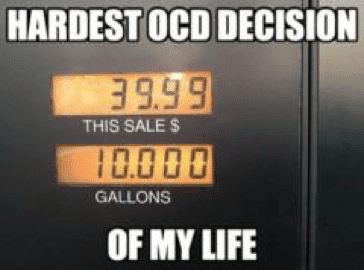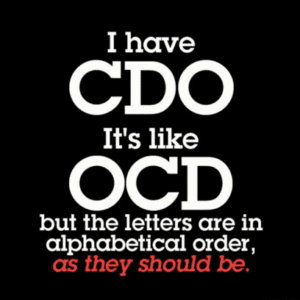Obsessive Compulsive Disorder (OCD): it’s difficult to think of an acronym– or a condition– more prone to parody. There was the infamous Target sweater incident, and there’s even an Obsessive Compulsive Action Figure sold on Amazon.com, complete with sanitary mask and moist towelette.
Don’t people take these things too seriously, though? And shouldn’t people be able to take a joke? Maybe. But try making an action figure or a sweater caricaturing another chronic and often debilitating condition– say, diabetes or Parkinson’s– and see how lightly people take it.

It’s not just big companies selling OCD products. There are also thousands of memes about OCD. Let’s look at a few of them.

The Problem With OCD Memes
What’s the problem with all this? I know, they’re just memes. And we’ve been through this type of discussion before, whether on the Huffington Post, in The Atlantic, or in online comics.
The problem is that people keep making the same jokes about OCD, while millions of people keep suffering. Although the prevalence of OCD can vary slightly, in the United States it’s 1 in 40 adults and 1 in 100 children. By that estimate, 6 million adults are struggling with OCD in the United States alone. People should know, when they make their memes or design their sweaters, that they’re making fun of a condition that haunts some of their friends, coworkers, and family members.
This isn’t to say that all our conversations about mental health have to be humorless– in fact, at least in the case of OCD, humor is one of the best ways to deal with the unpleasant thoughts and feelings constantly hammering away at you. But before you try to be funny, you have to know what you’re talking about. And OCD is not the desire to have things neat or clean.
How To Learn About OCD
There are countless great resources online for you to learn what OCD is, and for now I’ll let them cover the basics. In the interest of discovering more specifically what OCD is like for those who live with it, let’s quickly go through a few subtypes of OCD and how they affect people.
Researchers and clinicians talk about subtypes because OCD is what they call a heterogeneous condition: although all cases of OCD share certain traits (obsessions and compulsions), one case is usually quite different from the next, and treatment should be tailored to individual symptoms.
Relationship OCD
People with this subtype can spend hours every day ruminating over unwanted thoughts about their intimate relationships and partners. Unsurprisingly, it can end up making those relationships more difficult. It can also leave people feeling irritable and exhausted.
Obsession examples: “Is this the right relationship for me?”; “How can I be sure this is the person I should be dating?”; “Couldn’t there be someone better out there?”
Compulsion examples: Replaying feelings and memories (“Did we really have a good time together on that vacation?”); Asking other people if you seem like a good couple; Looking up past romantic interests on Facebook for evidence they’re no longer attractive to you
Harm OCD
Those dealing with Harm OCD are terrified that they will hurt someone in one way or another. They may constantly feel like they’ve already harmed someone. Usually these thoughts center around people very important to them, but sometimes people also worry they’re being harmful in everyday interactions with strangers or acquaintances.
Obsession examples: “I will lose control and kill my kid”; “I just ran over someone back there”; “I might walk right over to that person and push them off this bridge” ; “I offended them in that conversation we just had”
Compulsion examples: Telling yourself one hundred times that you love your kid and would never hurt them; Driving back and checking if you ran over someone; Avoiding bridges entirely so you won’t push someone off; Apologizing repeatedly, asking if the person is mad
Sexual Orientation OCD
People with Sexual Orientation OCD are in constant doubt about who they’re actually attracted to. Their mind seems to look for any sign that they might be attracted to someone of the same gender. They doubt the stability of their sexual orientation, as if they could “turn gay” if they’re not careful enough
Obsession examples: “I’m turning gay, I was attracted to that person back there”; “Other people can tell that deep down I’m not straight”
Compulsion examples: Avoiding people of the same gender to eliminate occasions for doubt; Watching videos of people of the same gender to test yourself for attraction to them
Pure Obsessional OCD (Pure-O)
People with Pure-O can have obsessions from any other subtype, but the key thing distinguishing them is that they don’t have any externally observable compulsions. They do have compulsions, but only they know it because the compulsions take place within their own head.
Obsession examples: “I left the stove on when I walked out the door, I’ll be responsible for killing everyone”; “What I just did was a sin and proves I’m not a good person”; “Nothing is worth doing and there’s no purpose to life”
Compulsion examples: Repeatedly thinking back through the steps you took when leaving the house; Forcing yourself to count to 200 in your head as penalty for your “sin”; Trying endlessly to think of something that is worthwhile
There are more subtypes to explore soon, and please let us know in the comments if you want us to talk about specific ones.
With all these subtypes, it’s not the thoughts themselves that are abnormal. In fact, pretty much everyone experiences these thoughts from time to time. What makes it OCD is:
1) The person experiences a lot of distress because of the thoughts, and because of the way they assess those thoughts
2) The person feels the need to do something to get rid of this distress
3) These attempts to get rid of distress can take up hours every day, interfering with core aspects of the person’s life
The second point is where most OCD jokes go wrong. People see the compulsion, like hand-washing or rearranging, and think it’s “so OCD.” They don’t realize that, in people with OCD, the compulsion is driven by a strong urge to get rid of something deeply unpleasant. What exactly is so unpleasant varies a good bit, as we’ve seen in these subtypes, but anyone resorting to compulsions is doing so because they feel very bad.
You might like things very clean or extremely neat, but that doesn’t mean you have OCD. And, by the way, OCD isn’t an adjective. You can’t “be OCD.”
We’ll be looking at many more subtypes here in the future, and investigating these ones more closely too. In the meantime, please leave us a comment with your own thoughts!
Where to Get Help For OCD Symptoms

If you are struggling with OCD please know that there is help out there. NOCD has therapists in all states and are available online. No need to travel to get the help you might need.
At NOCD, all therapists specialize in OCD and receive ERP-specific training. ERP (Exposure and Response Prevention therapy) is most effective when the therapist conducting the treatment has experience with OCD and training in ERP. If you’re struggling with OCD, please schedule a free call today with our care team to find out how OCD treatment might be right for you.

